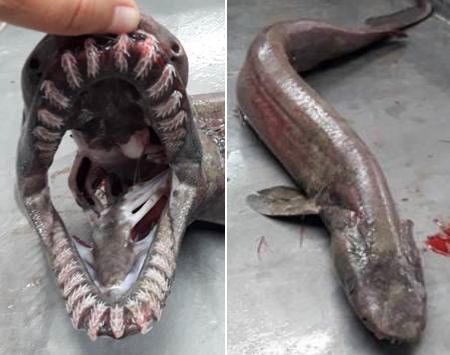 Despite having a wide geographical distribution, throughout the Atlantic and Pacific Oceans, this ‘living fossil’ shark is seldom captured as it spends it time swimming around at great depths.
Despite having a wide geographical distribution, throughout the Atlantic and Pacific Oceans, this ‘living fossil’ shark is seldom captured as it spends it time swimming around at great depths.
In August, Portuguese researchers captured a frilled shark, (Chlamydoselachus anguineus) off the Algarve coast.
The captured male was about 1.5 metres long, according to the Portuguese Institute for the Sea and the Atmosphere (IPMA).
"This shark, a true living fossil, has a long, slender body and a snake-like head. It also has a very particular dentition, its biology and ecology are little known," stated the institute.
Despite having a wide geographical distribution, "it is not very often captured because of the depths at which it lives," with the Algarve specimen caught 700 metres down.
The researchers from the IPMA and the Centre for Marine Sciences and the University of the Algarve were on board a commercial trawler under the MINOUW project, the ‘Initiative to minimize catches of unwanted catches in European fisheries.’
_________
Background:
The frilled shark (Chlamydoselachus anguineus) is one of two extant species of shark in the family Chlamydoselachidae, with a wide but patchy distribution in the Atlantic and Pacific Oceans. This species is found over the outer continental shelf and upper continental slope, generally near the bottom, though there is evidence of substantial upward movements.
It has been caught as deep as 1,570 metres, although it is uncommon below 1,200 m.
Exhibiting several "primitive" features, the frilled shark has often been termed a "living fossil” and reaches a length of 2 metres and has a dark brown, eel-like body with the dorsal, pelvic, and anal fins placed far back.
Its common name comes from the frilly or fringed appearance of its six pairs of gill slits, with the first pair meeting across the throat.
Seldom observed, the frilled shark may capture prey by bending its body and lunging forward like a snake. The long, extremely flexible jaws enable it to swallow prey whole, while its many rows of small, needle-like teeth make it difficult for the prey to escape. It feeds mainly on cephalopods, leavened by bony fishes and other sharks. This species is aplacenta viviparous: the embryos emerge from their egg capsules inside the mother's uterus, where they survive primarily on yolk. The gestation period may be as long as three and a half years, the longest of any vertebrate. Litter sizes vary from two to fifteen, and there is no distinct breeding season. Frilled sharks are occasional bycatch in commercial fisheries, but have little economic value.
From Wikipedia
























